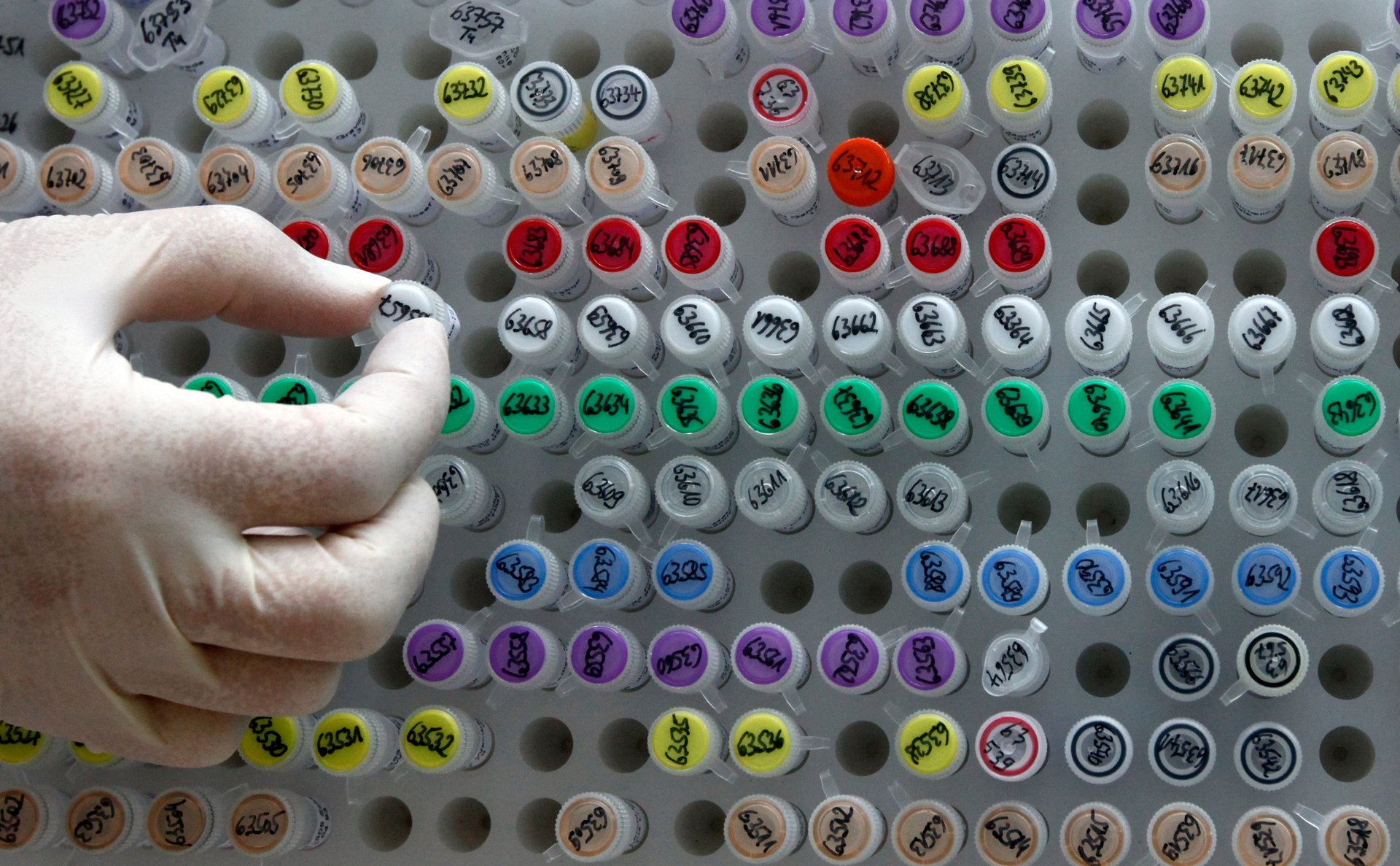We looked at the major scientific discoveries from five years ago to see where they are now
When scientists announce they’ve made a breakthrough, they usually promise we’ll see the full effects of those discoveries—anything from a better understanding of how the universe works to a drug ready for use in patients—in about five years. As 2017 comes to a close, we decided to follow up on these promises and see which of the biggest scientific developments from 2012 have actually stayed relevant.


When scientists announce they’ve made a breakthrough, they usually promise we’ll see the full effects of those discoveries—anything from a better understanding of how the universe works to a drug ready for use in patients—in about five years. As 2017 comes to a close, we decided to follow up on these promises and see which of the biggest scientific developments from 2012 have actually stayed relevant.
It’s been a mixed bag: Gene editing has become all the rage and physicists on a hunt for dark matter, but scientists still haven’t found alien life or developed a better male birth control.
The Higgs boson in 2012
Five years ago, physicists at the CERN Large Hadron Collider in Switzerland announced the then-largest physics news of the century: They had found evidence of the Higgs boson particle, which filled in a missing piece of the Standard Model, a physics concept used to describe what makes up and holds together our universe. François Englert, a physicist from Belgium, and Peter Higgs, a physicist from Britain, had predicted the existence of this particle back in the 1960s, and were awarded a Nobel Prize in 2013 after their theory was confirmed. (Though as with any modern scientific discovery, the prize didn’t acknowledge the work of many other scientists who contributed.)
The Higgs boson five years later
The Higgs boson is still big in the physics community, but is no longer the hot new thing. The Large Hadron Collider is now looking for other types of particles that fit the Standard Model—or shake it up entirely. In 2016, researchers from Hungary and the US claimed to find a dark photon using the LHC, which could help explain the vast, poorly understood world of dark matter, which is thought to make up a large chunk of the universe. The physics community, however, is still divided about the validity of the data underlying the claim. Meanwhile, plans for the newest high-speed particle collider to be built in Japan have been scaled back due to a lack of interest (and funding) from the Japanese government and the Japan Association of High Energy Physicists Japan Association of High Energy Physicists.
In recent years, gravitational waves have been hogging the physics spotlight. These waves were first discovered in 2016, and essentially proved Einstein’s theory of relativity on the largest scale yet by showing that ripples spread through space at light speed after the collision of two black holes. Since then, researchers have found evidence for them them twice more. In 2017, they even detected the collision of neutron stars, which opens up a whole new window to study the universe.
Crispr gene editing in 2012
In 2012, biologists made one of the most important advances in gene editing after 20 years (pdf) of research on bacterial genetics: They published (paywall) work outlining Crispr-Cas 9, a system that utilizes an enzyme found in some types of bacteria to edit DNA by cutting out certain sequences and adding in others. At the time, scientists at the University of California-Berkeley filed for a patent on the technology shortly before scientists at MIT and Harvard’s Broad Institute; however, the US patent office awarded the patent to researchers at Broad. Since then, there’s been a heated legal battle between the two parties.
Crispr five years later
Crispr remains one of the most popular advances in a range of scientific fields. For example, PubMed lists 3,098 studies mentioning Crispr published in 2017 compared to 331 in 2013. Since 2012, scientists have done all kinds of experiments using Crispr, ranging from making better food, modifying animals for use as medical research models, and even eliminating diseases in human embryos in laboratory settings.

Prenatal screening in 2012
Before 2011, the only way to test if a fetus had a genetic defect was to insert a needle into the amniotic fluid around the fetus. The procedure was far from ideal, though, because it can cause a miscarriage. Scientists knew that bits and pieces of a fetus’s genetic material floated around in its mother’s blood, and knew that, in theory, they could draw blood from the mother to test for genetic defects in the fetus. In 2012 and 2013, four companies started selling these tests to the public. (These initial tests could only check for Down syndrome, a condition marked by a mutation on the 21st chromosome.)
Prenatal screening five years later
Prenatal testing remains an option for expecting parents who don’t want to pass along a genetic disease they know they carry. However, concerns have arisen about the accuracy of fetal screening through blood tests. They tend to turn up false-positives, which may lead parents to unnecessarily terminate pregnancies. One analysis (paywall) from 2015 found that four out of every five times these tests showed a genetic defect for trisomy-13—an extra chromosome that usually results in the imminent death of a baby after birth—it was a false positive.
There are also ethical concerns. For example, in Iceland, prenatal genetic tests have led rates of Down syndrome—a non-fatal genetic disease—to drop dramatically in the past five years. But some people believe it’s wrong to to terminate a pregnancy when a prenatal test shows this sort of non-fatal illness. In Ohio this year, legislators made it illegal for a woman to have an abortion if they were doing so because their unborn baby had Down syndrome.
XNA in 2012
All life on Earth is made up of either one or two strains of genetic material. This material is always a nucleic acid attached to a sugar-type backbone, either called ribonucleic acid (RNA) or deoxyribonucleic acid (DNA).
In the beginning of the 21st century, scientists thought they could shake things up by coming up with other types of sugars to attach to nucleic acids. They developed “xeno nucleic acid” (XNA), which uses lab-made sugars as the spine of the genetic material. (“Xeno” means “alien” or “foreigner.”) In 2012, researchers from Arizona State University designed XNA that could actually evolve to pass along information, similar to natural genetic material.
The discovery opened up loads of possibilities for synthetic life. Researchers hypothesized it could teach us what kinds of life to look for on other planets, or could be used to make long-lasting, biologically-based medication.
XNA five years later
Although the scientists who published the initial research on XNA have continued to plug away at basic research in the field, including novel synthesis techniques, the technology still hasn’t made it out of the lab.
Male birth control in 2012
In 2012, we were promised reversible male birth control was just around the corner. Scientists had invented a compound that seemed to work in male mice and didn’t alter their sex drive—a common issue in previous novel forms of birth control for men.

Male birth control five years later
There have been a couple of promising clinical trials since, but they’ve been terminated either because men had bad side effects (which sound similar to the side effects many women experience with their birth control) or because no major drug companies would fund them.
Aliens in 2012
Five years ago, it felt like we were on the verge of discovering life outside our planet. At the start of 2012, astronomers had used the Kepler telescope to find more than 800 planets outside our solar system—less than a decade after the first one was discovered in 1995. At that rate, odds were one of them had to hold the right stuff for life, right?
Aliens five years later
Since then, scientists have discovered exoplanets by the thousands. In 2014, Kepler spotted the first considered potentially habitable based on its size and proximity to its star. In 2017, scientists reported evidence of several planets (and one entire solar system) that seemed like they could host life. But so far, when it comes to actual extraterrestrials, no dice. Maybe that’s not so bad. It’s definitely no sure thing that encountering alien life would be a good thing for humanity.

Giant telescopes in 2012
The Very Large Telescope (VLT), which belongs to the European Southern Observatory lacks a creative name but it at least lives up to it. The VLT is actually four separate telescopes that were connected in 2012 to created a massive virtual mirror with a surface diameter of 424 feet (130 meters). Reflection techniques help enhance this size of this mirror; each of the individual telescopes has a diameter of 27 feet (about 8.2 meters). At the time, it was the biggest optical telescope in the world, enabling scientists to capture images of objects that weren’t necessarily round, like galaxies and baby stars.
Giant telescopes five years later
This year, the ESO started building an even bigger single optical telescope, also in Chile. This one will have a mirror 128 ft (39 meters) in diameter, and will be aptly named the Extremely Large Telescope. There’s also the Thirty Meter Telescope, under construction on Mauna Kea in Hawaii, which, as its name suggests, will be 30 meters (98 ft) in diameter and the Giant Magellan Telescope, in Chile, which will be 80 ft (24.5 meters) in diameter.
Brain-computer interfaces in 2012
In 2012, researchers at Brown University announced that two paralyzed patients were able to use their minds to control a robotic arm to serve themselves a cup of coffee. It was the first time a paralyzed patient had used a brain-computer interface to move a prosthetic three dimensionally.
These first iterations of brain-computer interfaces (BCI) were pretty basic. The limbs didn’t have much dexterity, in part because the machine algorithms that turned neuron firing into prosthetic motion only allowed for input from only one part of the user’s brain. More complicated movements require more complicated neural signaling, and input from other senses.
Brain-computer interfaces five years later
BCI technology has advanced to include things like a brain-controlled robotic prosthetic arm with 26 joints, created by researchers at Johns Hopkins University in Maryland and the Defense Advanced Research Projects Agency. Most of these joints can move in isolation for more precise movements, and all directed by the thoughts of the arm’s user. It also enables some users to feel a sense of touch and pressure, which leads to more fluid movement.
Wearable eyeglasses tech in 2012

In 2012, Google was sure the next big thing in consumer tech would be spiffy computerized glasses. Google was woefully wrong. Glass was a huge flop, and it quickly became the butt of Silicon Valley jokes. In 2015, Google’s parent company Alphabet officially decided that it would take the wearables off the market, although they’re still available for sale to businesses.
Wearable eyeglasses tech five years later
There was a rogue software update for old glasses earlier this year, but a full revival of the project doesn’t seem forthcoming.
In late 2016 Snapchat also tried to make glasses a thing. The company’s Spectacles were designed mostly just so people could use the Snapchat app without their phones, but no one wanted to buy those, either.
Drugs to prevent HIV in 2012
The revolutionary pre-exposure prophylaxis (PrEP) treatment for HIV was first approved by the US Food and Drug Administration in 2012. The drug, sold under the brand-name Truvada, is intended to be taken alongside other antiretroviral drugs.
Drugs to prevent HIV five years later
In the past five years, statistical estimates have suggested that PrEP works around 99% of the time. Although the exact real-world prevention rate remains a little fuzzy (paywall), it still seems PrEP is the real deal.
Other types of HIV vaccines haven’t been nearly as successful. This year, researchers reported encouraging clinical trial results testing a new vaccine designed to account for HIV’s rapid evolution. However, of the four other clinical trials for this type of vaccine, three have failed.
Nevertheless, in part thanks to PrEP, the number of new cases of HIV per year is dropping globally; in 2015, there were just over 2 million new cases, compared to 3.5 million new cases at the epidemic’s peak 20 years before. The majority of the recent new cases were concentrated in countries in the southern region of Africa.
Correction: A previous version of this story compared the size of the Five-Hundred-Meter Aperture Spherical Telescope (FAST) in China to the VLT in Chile. However, FAST is a radio telescope and the VLT is an optical telescope, which means they have different construction considerations. The article has been updated to remove the comparison.